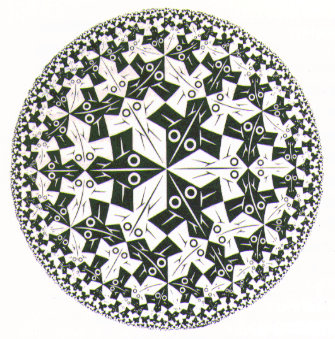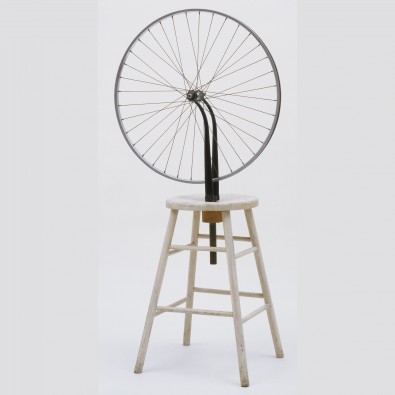
To infinity — or maybe not quite
Years ago, during a trip to India, I lay my head down to sleep in the vicinity of a booming jungle rave. As I dozed, I dreamed I was climbing up a mountain path, twisting and turning along rocky switchbacks that soared into an empty Technicolor night. At the top of the mountain, with almost cartoon predictability, sat a bearded wise man in a robe. He taught me that reality was like a television set, and that all one had to do to master time and space was to learn how to change the channel. This skill he passed to me instantly, and soon I was cycling through any number of parallel worlds, or parallel versions of this world, zapping through shifting landscapes that distinguished themselves more than anything else through cheap, candy-color mutations of hue and contrast.
I don’t recall how long I reality-surfed, but soon a strange feeling welled up inside me: boredom on a cosmic scale, an existential nausea that knew no limit, since there was no longer any limits to know. The endless permutations of the real made available to me by my new psycho-spiritual tech utterly deflated my urge to explore, since the very frictionless of the multiverse before me, the very endlessness of its possibilities, somehow drained the life that animates possibility, rendering the mystical All a meaningless wank.
This heavy but goofy dream, no doubt conjured in part by the psychedelic vibes riding the bass frequencies that knocked my skinny frame awake at 4 am that night, introduced me to a quandary that, I want to humbly suggest, dogs the heels of every future-lusting reality hacker: when you arrive on the shores of full designer reality, that nest of infinite parameters glimpsed by psychonauts, VR visionaries, and Singularity-watchers, what do you do? Where do you go? What organizes desire in a frictionless hyperspace?
Admittedly, these are SciFi speculations. We have not even come close to the cornucopia of infinite malleable realities imagined by high-flying futurists like Ray Kurzweil and Eric Drexler. And given the noise that always seems to garble the human signal, not to mention our all too worldly concerns these days, I suspect we never will. But the dream of designer reality — a dream that imagines a future of endless permutation and perceptual play, in which desire directly shapes our experience — feeds the attractive power of our most tantalizing technologies, at least in their more fantasized forms (and technologies are always concealed fantasies). Regardless of the dotcom bust or the violent turbulence unleashed by terrorism and globalization, technology will continue to push the limitations of human life — the bookends of matter, memes, and mind — until they approach the asymptote of the Infinite.
It is no accident that natural philosophers like Descartes, Leibniz, and Newton began to explore the mathematics of the infinite when they did. The seventeenth century was ground zero for modernity, a time when the Endlessness of heaven condensed into terrestrial fuel for the expanding engines of science and capitalism. The invention of the mathematical limit was only one of a number of developments that signaled the emergence of a new, restless, and rapacious sensibility. For of course the limit allows you to grapple with the infinite, to make a pass at the All inside the frame of calculation. In this spirit, Newton destroyed the bounded cosmos of the medieval mind, while Descartes unfurled the infinite homogeneity of space Ð- an abstract and materialist form of infinity that continues to influence the construction of virtual worlds, our latest technology of the Endless.
Such cosmological shifts mirrored the dynamic explosion of arts, sciences, technologies and travel that characterize modernity. Many factors influenced the modern West’s extraordinary production of intellectual novelty and material wealth, not to mention its horrible and restless hunger for power and global goods. But it seems fair to characterize this dynamic as the catalytic result of injecting a little bit of infinity inside the relatively static confines of the medieval world. Another way of saying this is that the space of possibility greatly increased. Rather than maintain the tradition of Tradition, civilization set its sites on overcoming space, time, disease, even matter, not to mention the limits imposed by pre-modern forms of social and cultural authority and power. In the eighteenth century, Hegel articulated this dynamic as a dialectical unfolding that progressively subsumes and transforms the finite shells of historical things into infinite spirit.
History does not really work that way, of course, but the appeal of the Limitless does loosely correspond to the emergence of wider spaces of possibility, and thus continues to organize collective desire. How do we relate to the immense spaces of possibility that are emerging from within our technologies and media? Do we exult or tremble? Are these spaces new playgrounds, or glimpses of the abyss? Though I am immensely amazed by history’s drive to achieve the Limitless by whatever means necessary, I fear that as we breech the walls that have shaped the human condition, we will find our perennial restlessness and dissatisfaction unappeased, even as we discover that the beings we felt ourselves to be were, at the most basic level, shaped by those boundaries. We will float free in the space of possibility, an experience that may conjure as much fear, nausea and nihilism as the liberation and glee we are promised. At the very least, I suspect we need to question the habitual “American” reaction to limitations, which is to believe that we can and should remove them. For even if we achieve some manner of limitlessness, that lack of friction becomes itself an enormous limitation.
Think about cultural technologies for a moment, today’s new-fangled apparatus of art and media: music gear, graphics engines, VR authoring systems, digital video tools, sound design systems, etc. These systems sell themselves in many ways by extending the range of parameters, control processes, and manipulative effects that greet the artist. They radically increase, on a technical level, the space of possibility. Indeed, the hype surrounding so much of this gear often implies that earlier media technologies were flawed simply because they were more constrained. In contrast, today’s more open-ended technologies seem to necessarily enhance creativity by expanding this space. But this idea may be, in some profound sense, utterly wrong.
The problem is that, in many ways, creativity is born from the struggle with constraint, not just with psychological and political blockages, but also with the formal limitations that characterize traditional media. Compare the latest Roland synthesizer with a bamboo flute. On the surface, the latter presents any number of massive formal limitations of timbre, range, dynamics, and key. But a great player can make space for art to sound the power and grace of the infinite inside that severely constrained vessel. This paradox can be understood by comparing it to the problem of measuring a coastline (a widely invoked problem in the chaos-science-mad days of the early 90s). Initially, a given section of coastline will be described by a fixed and finite number. But as you attempt to measure that same section of coast at finer and finer scales, the coastline keeps getting longer (not to mention changing its shape). This process is effectively infinite. Indeed, the coastline can only be characterized in terms of a fractional dimension. So too may we approach the freedom and play of the infinite within a narrow tube of bamboo. In other words, the infinite is already immanent to the constrained forms of ordinary life.
Of course new media tools have their own formal limits, their bugs, blindsides, and idiocies. But these limits are largely abstracted, arbitrary and hidden, and they change in often unpredictable, equally arbitrary ways as the technology changes. In addition, they just aren’t around long enough to develop a tradition of engagement, in which such “artifacts” come to shape the particular character of an instrument of expression, like the resonance available on the open strings of a guitar. Artists earn their creative bread by turning such artifacts on their heads, transforming bugs into features, and so you get Pixelvision in cinema or the squelchy beats of the Roland 303 forming the bass lines of classic techno. But too many of us experience the limitations of software and hardware as only temporary impediments to a zone of expression that will be limited, supposedly, only by our own imaginations. And so we upgrade.
Compare this framework to the constraints faced by the wood-worker, whose expression of form, however imaginative, must also follow the peculiar grain of a particular chunk of wood. Rather than simply deploying the imagination inside the frictionless context of the digital realm, the artist must also allow the material itself to manifest the little explosion of novelty we recognize as art. It may be that, as we make the digital arena of expression increasingly malleable to the pure imposition of the creative will, we actually deplete our imaginative resources. This, at the core, is the tragedy of Hollywood special effects, whose idiotic drive to simulate reality while maximizing our gut reactions may disguise a deeper anxiety about how to navigate the void that opens up once we can simulate anything we can imagine.
As I suggested above, the vertiginous abyss opened up by the new media’s exploding space of possibility is itself a formal “limitation,” although of a different order than those imposed by a bamboo flute or the foam rubber models of old SF movies. This new constraint is an existential-technical-aesthetic condition, one which itself must be grappled with directly, as part of our challenge as artists and thinkers. There are a number of conscious responses to this condition already emerging. Many involve the swerve away from the artist’s creative will towards more open systems. We find artworks that depend upon automatic, algorithmic processes, or the translation of external dataflows into new forms. In this way, art is less made than grown.
Still the problem of affirming and choosing limitations continues to lie at the core of artistic practice, a problem in many ways forced on us by the new technologies. DJ Olive, avant-garde turntablist and member of the electronic group We, recently addressed the almost absurd range of possibilities introduced by new sonic technologies and applications: “Its not what you do. Its what you don’t do.” In other words, faced with a large space of possibility, the artist becomes selector. In the face of the dream of the limitless, a fantasy that reflects both the rhetoric and the reality of new technologies, we may find that we must also come to dream our limit.
This perspective clarifies a number of contemporary twists and turns, both within art and culture as a whole. One trend is the turn towards “design” as a ruling paradigm, whether we are talking about objects, spaces, or Web/virtual environments. With or without an explicit nod to commerce, “design” still carries with it the notion of functionality, which in turn restrains the boundless possibilities of the form. In other words, utility helps hone the space of possibility. The paradox of course is that the desires that drive the consumption of stylish but useful things are themselves under the sign of the infinite — they are engines of a quenchless yearning. At the same time, “design” suggests a pragmatic, almost Darwinian environment of selection — a market based on use-value, including aesthetic use-value (style). Amidst the perennial crisis of modern art, which has only been compounded by our machines and their expanding spaces of possibility, the constraints imposed by such a market lend ballast to creation of new form.
One might also note the popularity and resonance of traditional Japanese design today. In this marvelous universe of atmosphere and craft, we find issues of limit and restraint approached through an impersonal dance of form and emptiness, and through the maximalized minimalism of small objects, plain organic materials, and subtle gestures and elliptical frames. One iconic element in the Japanese design universe is the fold, a curve whose dimension, like the coastline, suggests the infinite snuggled within the finite two-dimensional plane of a surface. But Japanese folds are utterly unlike the rococo folds of the Baroque, which express the early modern hunger for the infinite through an almost mad profusion of pleats. Instead, traditional Japanese modes of expression demands restraint, because only with the application of immense formal control can you make room for a kind of spontaneity that arises beyond human control — a spontaneity that is often allied, if not ascribed, to nature’s productive grace.
One reason we respond to this dynamic today is that the environment — the biophysical matrix that surrounds and grounds us — has become the site for massive and justifiable cultural anxieties about limitation and restraint. The environment is no longer a bountiful source of goods and sublimity, but a severely stressed complex system with depleted resources and limited carrying capacity. So in contrast to the apocalyptic drive of technological modernity, which strives to realize the infinite beyond the petty bounds of nature’s givens, environmental activists and artists acknowledge and even affirm the wisdom and necessity of limit, of moderation, of balance. In place of the infinite vector of Progress, driving into deep space, we embed ourselves within a cycle dominated by Return. The problem is that nature’s complex productivity and our own technological savvy make it tough to know where and how massive restraints need to be applied. When it comes to nature, limitation is a moving target.
The same truth applies to artists and activists who recognize the value of affirming and working within limits rather than submitting to the pervasive hype about boundless possibilities. This is a marvelous, perhaps necessary intuition, and yet such convictions are often not directly linked to necessity, at least in any obvious way. For example, if you want to apply the ideas of Voluntary Simplicity to your own life, then how and why do you decide what activities and ambitions you will abandon on your way to balance? The arbitrariness of these decisions helps lend a faint absurdity to what is, in some sense, a question of design. But how and why we self-consciously impose limits is an immensely difficult question, one that exceeds ecological science and enters the realm of values and metaphysics. As DJ Olive implied, the choice of what not to do is just as difficult, if not more so, than the choice of what to do, and requires at least as much wit and grace. Today, in so many fields, we explore through an application of reduction. We create with the cut.




